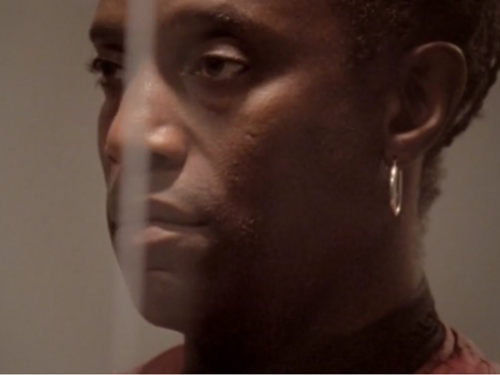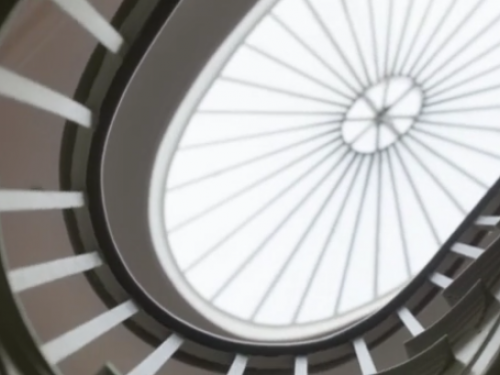Standing on the Shoulders of Giants
Age and inspiration with a STOP PLAY RECORD filmmaker
What will happen when average life expectancy reaches 100? Watch an experimental film by STOP PLAY RECORD filmmaker Jessica Bishopp, released on Channel 4, and read about the directors who inspired her.
This is the second post in our series in which STOP PLAY RECORD filmmakers tell us about their influences.
We are currently living precarious lives in a time of great change, lives that are potentially incredibly long thanks to our increasing life expectancy. With my short experimental film Lifespan I wanted to explore what happens when average life expectancy reaches 100 - I aimed to question our desire to preserve this life. I looked to architecture and science to form the story and visuals, exploring their social significance, how they relate to people.
"Lifespan visually challenges preconceptions about age through its use of architectural spaces and locations."
Age and architecture are linked. Visually, age is often associated with enclosed and cluttered space. Lifespan begins enclosed, kitsch and cluttered and slowly opens up, visually challenging preconceptions about age through its use of architectural spaces and locations.
I used the largest prefab estate in the UK—the Excalibur Estate in Catford—as a metaphor and the visual starting point; row upon row of rectangular self-contained houses that have survived over 50 years longer than they were intended to.
Will we develop a better way of preserving and storing memories and bodies, or will we be a forgotten generation stuck in nursing homes, not remembering our own names? What is the point of living to 100 years when you cannot guarantee a decent quality of life or your own home to live in?
"Will we develop a better way of preserving and storing memories and bodies, or will we be a forgotten generation stuck in nursing homes?"
I focused on researching filmmakers and artists who depict architecture and place continually in their work, within a social context. I was also influenced by artists who used sound and the voice in experimental ways to tell stories and as a key element of their filmmaking style.
Clio Barnard
Sound and voice are incredibly important in Clio Barnard’s films, such as her early short experimental film Random Acts of Intimacy (1998) exploring stories of brief sexual encounters with strangers and then her later theatrical feature film The Arbor (2010) which tells the story of playwright Andrea Dunbar. Both films cleverly use lip-synced interviews and actors. Her interview style and the resulting intimate and honest stories she collects and tells in return was something I also wanted to experiment with. From multiple separate interviews and voices, I wanted to create something that felt like an intimate conversation between strangers, forming an overarching atmosphere and collective conscience.
This was combined with an architectural visual collage to create a futuristic dream based within our current reality. In Lifespan, the sound and voice was important in creating a familiar yet unsettling and futuristic atmosphere. I wanted the sound design and music, with its eerie drawn-out notes and mechanical tones, to be juxtaposed against the familiar, kitsch and homely visuals, in a similar style to David Lynch.
Joseph Cornell
The way in which Joseph Cornell examines and captures the city in a lyrical way inspired me. His short experimental films such as Angel (1957, 3m, colour, silent), set in a cemetery, and Gnir Rednow (1955-1960/1970, 5m, colour, silent, Stan Brakhage), focusing on the overground railway, both explore the theme of place. Cornell’s films allow for contemplation, reflection and juxtaposition in the information they show but also in the information they withhold such as sound.
"The way in which Joseph Cornell examines and captures the city in a lyrical way inspired me."
His non-linear approach and experimental visuals allow the audience space to bring themselves into the experience of the film and contribute themselves which is something that influenced the way in which I wanted to make my film Lifespan. Space, environment, travel and exotic places were all key themes of Cornell’s work that in turn has influenced my own.
Ben Rivers
The poetic, hypnotic films of artist filmmaker Ben Rivers, that toy with the similarities and differences between documentary and experimental film, have influenced my filmmaking since I saw Sack Barrow (16mm, 21min, col, 2011) screened at the Hayward Gallery when it was first released. Sack Barrow explores a factory on the verge of closure; its sounds, its textures and all the memories the physical space holds. I then saw the UK premiere of Two Years at Sea (88min, 16mm anamorphic , b/w, blown-up to 35mm, 2011) at the BFI, which once again looks at how humans inhabit space—a theme that has always interested me—telling the meandering story of a man who lives alone in a remote and wild forest.
"I aimed to create a tactile and photographic style, similar to memories and the act of remembering."
Like Ben Rivers I have enjoyed experimenting with a sense of visual stillness and nostalgia - allowing action to unfold within the shot, composing the shot like a photograph and allowing the details within the composition to emerge. I hope I have achieved this in my film Lifespan. I aimed to create a tactile and photographic style, similar to memories and the act of remembering.
Julian Rosefeldt
I recently saw Julian Rosefeldt’s experimental film installation, Manifesto (2015), exhibited at the Hamburger Bahnhof in Berlin. Full of passion, ironic and satirical humour, anger and inspiration, he revitalises, recontexturalises and appropriates the fiery artist manifestos of the past using Cate Blanchett as his muse.
His 13 futuristic films, in which sound and the voice are incredibly important, paired with luxurious visuals and high production value will influence my films to come. ■
STOP PLAY RECORD is a programme for young people interested in learning how to make experimental short films and being introduced to experts working across moving image sectors.
Learn about upcoming workshops and events.
Watch Jessica Bishopp's film, part of the new Random Acts series. All images in this piece are film stills or behind-the-scenes shots from Lifespan.
This article is posted in: Articles, Blog, Events, Film
Tagged with: Stop Play Record, Saskia Dixie, learning, arts education, Standing on the Shoulders of Giants, Filmmaking, Experimental Film, Short Film, Young ICA













